Reimagining the city
Our new collection of material from the Festival of Transitional Architecture (FESTA) has been a long time in the making. We’re delighted to be able to present a huge number of photographs, videos, programmes and site maps for each of the three FESTA events of 2012, 2013 and 2014. A huge thank you to all the photographers and film makers who have contributed, and to FESTA Director Jessica Halliday for seeing it through.
Rosalee reflects on her FESTA experiences:
Memories of Labour weekend 2012 are still clearly embedded in my mind. On the night of Saturday 20 October I cycled into town with a group of friends, only to find there was no point trying to bike any further once we reached the central city. We’d hit an enormous crowd of people filling the streets for LUXCITY – "a city built of lights that existed for one night only", and the headline event of the inaugural Festival of Transitional Architecture (FESTA). The only sensible option was to lock our bikes to one of the ever-present chain-link fences and allow ourselves to be swept into the slowly moving sea of pedestrians.
I’d lived in Christchurch for almost 5 years at that point, and aside from the occasional experience of a packed night club in my first years of University, I’d never experienced such a crowd. People were literally shoulder to shoulder, cameras and cell phones in hand, all of us craning our necks for a first glimpse of the transformed Red Zone. The atmosphere was one of excitement, anticipation and curiosity.
Let’s not forget this was the first time the central city had been open to the public since the February 22 earthquake. The cordons had been lifted for the night, and everyone wanted in.
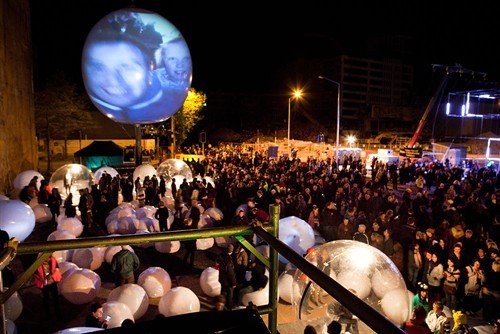
An installation titled 'In Your Face', which was part of LUXCITY. Photograph by Bridgit Anderson, Creative Commons BY-NC-ND.
And no wonder - LUXCITY was breath-taking. I was both disorientated and filled with awe. All around me were huge, glowing structures, set against eerie silhouettes of partially-demolished buildings and vacant sites. I remember having just figured out that I was standing on Gloucester Street, near where the Farmers building had been, but feeling as though I was on the set of a post-apocalyptic sci-fi movie. It was surreal. To this day, no other single event has brought as many people back into the city post-earthquake.
I spent the evening playing like a child among interactive sculptures, dancing, eating, bumping into friends at every corner, and attempting to photograph the amazing city of lights. It wasn’t long before I realised that my little point-and-shoot wasn’t going to do any of this justice however, and chose instead to simply immerse myself in the moment.
Thankfully, the LUXCITY collection in QuakeStudies contains hundreds of photographs of all the amazing temporary creations, and they are far better than any of the snaps I took!
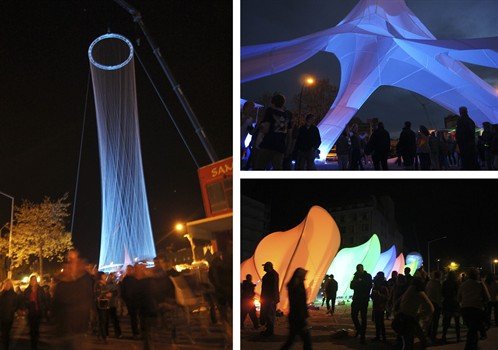
LUXCITY installations titled Altitude (left), Kloud (top right) and Silhouette Carnival (bottom right). Photographs by Erica Austin, Creative Commons BY-NC.
I remember biking home that night feeling invigorated – our city had come back to life! Christchurch was an exciting place to be.
This first FESTA event certainly set a high precedent for the subsequent years, but the organisers outdid themselves in 2013 with Canterbury Tales – "a carnivalesque procession through the former Red Zone", led by Free Theatre Christchurch. Giant hand-crafted puppets and masked performers led the public along the Avon River from the Bridge of Remembrance to Cathedral Square, stopping for various interactive installations and performances along the way.
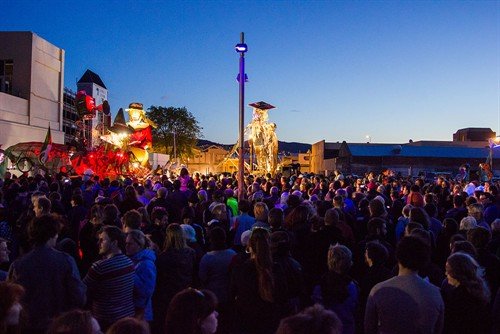
A crowd gathered on Cashel Street for Canterbury Tales. Photograph by Jonny Knopp, Creative Commons BY-NC-ND
Free Theatre artistic director Peter Falkenberg explains in this film about Canterbury Tales that they were working with an old, medieval notion of the Carnival, originally established as a way to bring people out of their houses where they may have been hiding from the plague, and back into the city.
The old, "medieval" city of Christchurch had been more or less destroyed, and Canterbury Tales sought to encourage a re-discovery of those parts that were no longer familiar – the places that needed to be “made home again”.
FESTA is far more than a night of entertainment and wonder. Each Labour Weekend programme is packed to the brim with talks, performances, activities, art projects and events for all ages. The 2014 programme was no different. From gardening workshops at Agropolis urban farm, to retro sporting events on the then newly-established Gap Filler Commons - there was something for everyone.
CityUps was the main event of 2014, and was very much reminiscent of LUXCITY. Two blocks of the central city were transformed into a "city of the future", abuzz with pop-up cafes and markets, performance spaces, discos, bars and street games, all based in and around a series of magnificent, large-scale, architectural sculptures.
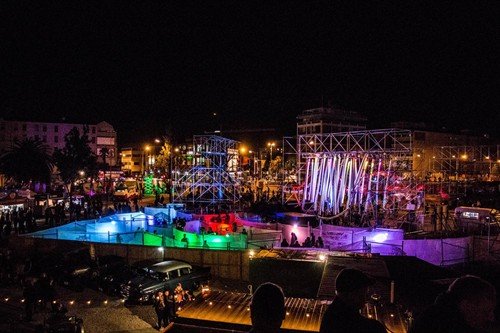
CityUps installations at the intersection of Lichfield, Manchester and High Streets. Photograph by Erica Austin, Creative Commons BY-NC.
FESTA has an ethos of cultivating imagination and experimentation. As Director Jessica Halliday puts it in this promotional video, FESTA is about creative people imagining Christchurch differently, so that we can all experience Christchurch differently. "This isn’t just about ideas and proposals on paper… FESTA provides a way for these feats of imagination to become real for a weekend."
This ethos is more than just a feel-good strategy – it’s a way of creating and influencing real change. On a recent visit to Christchurch, Gil Penalosa, Urbanist and Founder of the 8 80 Cities think tank, stated that he thought Christchurch officials should experiment more. "Pilot projects are great… They allow citizens to see whether it will work or not." Penalosa used the example of New York City replacing car parks on Broadway and in Times Square with temporary parks, cafes and seating. These pop-up spaces are now permanent.
What’s more, during an interview for the Canterbury Tales film, Free Theatre Producer George Parker pointed out that FESTA is line with many interesting projects happening internationally, which are "moving away from this notion of large structures, and cities being based around iconic buildings, and much more going towards the rituals, the events, the happenings that actually bring people together - the rituals that actually give a sense of place and identity."
FESTA is a way for "artists, musicians, grandmothers, citizens, performers, and communities" to reclaim their city. It’s an opportunity for all of us to change our thinking about what and who makes a city, and to engage, both physically and politically, with the making of Christchurch.
FESTA is now a biennial event. It is still governed by the Christchurch Transitional Architecture Trust, but is now presented and produced by Te Putahi – Christchurch centre for architecture and city-making, which exists to create space for people to learn and develop as citizens, neighbours, and as built environment professionals.
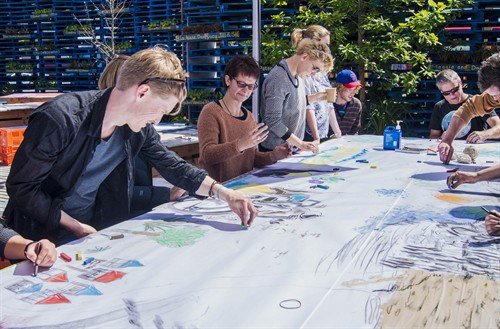
Participants of Supernova City, an imaginative drawing workshop led by Melbourne-based architect Bryon Kinnaird. Photograph by Erica Austin, Creative Commons BY-NC.
We are fast approaching this year’s event, which is themed 'We Have The Means'. The 'means' being celebrated here are twofold: citizens who have a passion for the city’s on-going development, and material resources – especially waste streams – that can be upcycled into ethical objects of beauty and function.
If the past three events are anything to go by, we should prepare to be amazed. I for one know there is no other place I would rather be this Labour Weekend.
For more information about this year’s FESTA, visit the website or head over to FESTA’s Facebook page.
